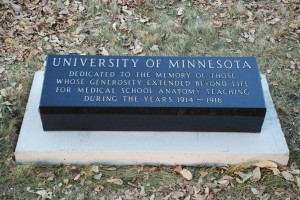
This marker was placed on the grave of 350 people provided by the University of Minnesota on 11-11-11. UNIVERSITY OF MINNESOTA Dedicated to the memory of those whose generosity extended beyond life for medical school anatomy teaching during the years 1914-1916.
By Sue Hunter Weir
There are 350 people buried in the cemetery”'s Potters Field whose remains were used as research subjects in anatomy courses at the University of Minnesota during the years 1914-1916. They were, to the say the least, a colorful lot: homeless men, prison inmates, men who were both the instigators and victims of crime. If they had one characteristic that they share was their social isolation; when they died, their bodies went unclaimed by friends or family. Other traits that many, though not all of them, shared, were alcoholism, mental illness and the effects of poverty.
In the early part of the last century, state law required the county coroner to turn over the remains of anyone whose body went unclaimed to medical schools. Because so many people believed that their bodies and souls were to be reunited on Judgment Day, the idea of dissection was, for the majority of people, unthinkable. As a result, there was a shortage of cadavers which made the laws governing unclaimed bodies necessary. (That practice ended in the 1960s).
Of those 350 people buried in the cemetery, 100 were infants who were stillborn or died shortly after birth in one of the two major charity hospitals in the area. Of the remaining 250, eight were adult women; the rest were men. The lives of the men are surprisingly well documented. In many cases, their deaths occurred in public places: in rail yards, on the street, at construction sites, or in jail. Eleven of the men have reams of paperwork, relics from the time they spent as inmates Stillwater Prison. Another nineteen of the men are identified only as “unknown man,” who, although their names weren”'t known, died under circumstances that were considered newsworthy.
The death certificate for one of those men lists his occupation as “yegman,” meaning he was a safe cracker. Police believed that he was one of several men who robbed the Thief River Falls railroad station of $7,500 in October 1913. When the robbers got together to divide up their “earnings,” a fight broke out and the unknown man was shot and killed by the other members of his gang.
Dan McMahon, a former prize fighter from New York, was another victim of a gang of robbers. He spent the evening of December 12, 1913 drinking in a downtown saloon where he made the mistake of showing a large roll of cash to some of his drinking partners. It wasn”'t long before a fight broke out, and the bartender threw all of the men out of saloon. Out in the alley, another brawl ensued, and McMahon was shot. He was taken to the City Hospital where he died, but not until six days later. In the meantime, the police were hunting for the seven men who assaulted him. They tracked them to a boarding house in St. Paul where still another brawl broke out. Eventually the police managed to arrest all seven of the suspects and haul them off to jail. Patrick Ballard, one of the men arrested for being involved in the assault on Dan McMahon, was promptly sentenced to 90 days in the workhouse. After serving only two hours of his sentence, he dropped dead of a heart attack, six days before Dan McMahon, the man he was accused of assaulting, died. And, there is another ironic twist to the story: both Dan McMahon and Patrick Ballard wound up buried in the same grave.
Most of the other stories are not as melodramatic as these, but many of them are fascinating in their own way.  Some of the people suffered from alcoholism or mental illness. Tuberculosis was a leading cause of death among this group just as it was in the population at large. But, regardless of how they died, they were for the most part forgotten.
That has changed. On November 11, 2011, a marker, provided by the University of Minnesota, was placed on their graves. It is a stunning black granite marker with a simple explanation about who these 350 people were and acknowledging their contribution to research. The marker will be dedicated and an observance held some time next year. Everyone who is interested will be welcome to attend.










Most excellent article, Sue. Thank you for advocating for these 350 people in Potter’s Field of Pioneers & Soldiers Cemetery.